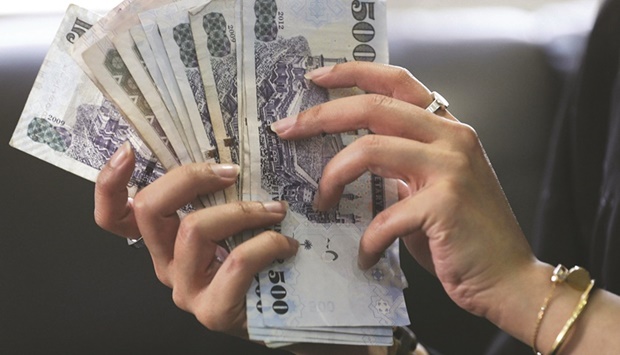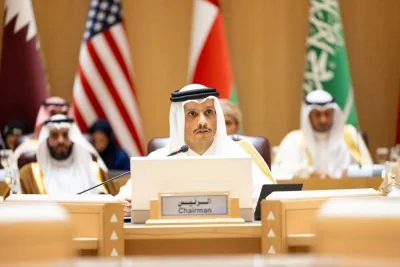Gulf Arab central banks followed the US Federal Reserve and raised interest rates by a quarter percentage point for the first time since 2018, though higher oil revenues mean governments can spend more to cushion the impact of increasing borrowing costs.
Policymakers in countries including Saudi Arabia and the United Arab Emirates tend to match the Fed’s decisions to protect their currencies’ pegs to the US dollar. While price pressures in the region aren’t as severe as in the US, where inflation is at the highest in four decades, the strength of the post-Covid rebound warrants monetary tightening, according to Oxford Economics.
“The economies of the region are robust and will be resilient to tighter monetary policy, and with inflation rising, higher interest rates are also probably needed,” said Scott Livermore, chief economist for the Middle East at Oxford Economics. “If the Fed moves faster than some countries feel comfortable with, fiscal policy can be used to support growth.”
n Kuwait was first to announce a 25 basis point increase in its discount rate, taking it to 1.75%. The oil-rich nation has more flexibility in setting rates as it maintains a peg to a basket of currencies. Inflation in Kuwait is among the highest in the Gulf after accelerating in January to an annual 4.3%, the fastest since at least 2017
n Bahrain raised its key policy rate to 1.25%, its overnight deposit rate to 1%, the four-week deposit rate to 1.75%, and lending rates to 2.5% from 2.25%
n The central bank of the UAE raised the overnight deposit rate by 25 basis points
n The Saudi Central Bank raised its repo rate by 25 basis points from 1% to 1.25% and the reverse repo rate by 25 basis points from 0.5% to 0.75%. SAMA, as the bank is known, said in its communique that the adjustments are consistent with policy makers’ “objectives of maintaining monetary stability and supporting the stability of the financial sector in the evolving domestic and international monetary conditions.”
With the Fed likely to embark on a prolonged period of higher rates, the pace of its monetary tightening could create a dilemma across the six-member Gulf Cooperation Council as authorities look to sustain non-oil economic growth and diversify away from energy.
In the Fed’s so-called “dot plot,” officials’ median projection was for the benchmark rate to end 2022 at about 1.9% and then rise to about 2.8% in 2023. They estimated a 2.8% rate in 2024, the final year of the forecasts, which are subject to even more uncertainty than usual given that Russia’s invasion of Ukraine and new Covid-19 lockdowns in China are buffeting the global economy.
A rebound in non-oil economic activity and low real rates when adjusted for inflation should provide the region’s economies enough scope to absorb the Fed’s rate hikes this year, said Monica Malik, chief economist at Abu Dhabi Commercial Bank PJSC.
“The stability linked to the pegs outweighs the fact that the US and Gulf Cooperation Council countries can be in different economic cycles or have different inflation rates,” she said.
Countries in the region were hit hard by the pandemic in 2020 as coronavirus lockdowns and disruptions to trade and tourism coincided with a slump in crude oil, their main source of income. Policy makers responded by following the Fed in cutting rates to near zero, unleashed massive fiscal stimulus and provided regulatory forbearance measures for banks.
For economies without independent monetary policy and flexible exchange rates, fiscal spending can pack a more powerful punch. Oil prices around $100 a barrel are now above levels that most Gulf countries need to balance their budgets this year, according to calculations by the International Monetary Fund, giving governments more scope for increasing expenditure.
“The GCC may see higher interest rates this year as it follows the US Fed hikes. But the surge in oil prices will give governments enough firepower to offset this drag. The net effect of fiscal loosening and monetary tightening will likely be faster, not slower growth,” says Ziad Daoud, chief emerging-markets economist, Bloomberg Economics.
Most countries in the region have so far kept their spending stable since the pandemic. Saudi officials have said they will keep expenditure fixed regardless of fluctuations in oil, a marked contrast from previous years when oil booms led to waves of spending on new projects and expensive handouts.
Even with higher rates looming, there may be little urgency to consider new stimulus. Non-oil business conditions have improved this year in Saudi Arabia and the UAE, the region’s two largest economies, driven mainly by the easing of pandemic-related restrictions and a gradual global return to normalcy.
“Past experience shows that swings in oil prices tend to be a stronger driver of credit growth in the Gulf than higher interest rates,” said James Swanston, Middle East and North Africa economist at Capital Economics.

A Saudi woman counts Saudi riyal banknotes at a money exchange shop in Riyadh (file). Policymakers in Gulf countries including Saudi Arabia tend to match the Fed’s decisions to protect their currencies’ pegs to the US dollar.


